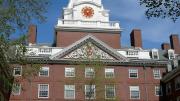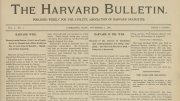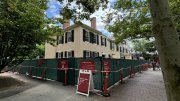Harvard announced today that Dunster will become the first of its 12 undergraduate Houses to be fully renewed under an ambitious, multidecade program in which the River House renovations alone are expected to cost more than $1 billion. Faculty of Arts and Sciences (FAS) dean Michael D. Smith and Harvard College dean Evelynn M. Hammonds said that under the plan, which requires approval by the Harvard Corporation, Dunster—the smallest of the neo-Georgian Houses along the Charles River—would be taken out of service for 15 months (one academic year and the two surrounding summers) in order to complete the project. Work is slated to begin in June 2014.
Students in Dunster would be housed temporarily at the Inn at Harvard and in nearby University-owned apartment buildings during the 2014-2015 academic year. The Inn, when constructed in 1991, was intended for temporary use as a hotel until needed for other University purposes. It will close by July 2013 to be refitted with student beds, a dining hall, and other social and program spaces integral to every House.
Dunster, constructed in 1930, is one of the earliest of the seven Houses built according to a plan developed by President A. Lawrence Lowell and funded by the generosity of Yale alumnus Edward Stephen Harkness. The House was named in honor of Henry Dunster, who became the first president of Harvard College at the age of 31, immediately after his arrival in the colony of Massachusetts Bay in 1640. It houses about 315 students.
Following the renewal of Dunster House, FAS and the College will assess the test projects at Old Quincy (now underway) and at Leverett House’s McKinlock Hall (slated to begin in the summer of 2013), before embarking on the renewal of a second House during 2016 and 2017. “Our commitment to providing an unparalleled liberal arts education and student experience in a residential setting is unwavering,” Smith stated in the official announcement. “We will apply the lessons we learned from those two projects as we begin planning for Dunster’s renewal.”
“House renewal is one of the most complex projects we have ever undertaken,” he continued. “At the start of our planning, we carefully reviewed similar projects at peer institutions. At Harvard, we deliberately designed the program so that we would test design, financing, and construction concepts on portions of Houses before undertaking the renewal of the first full House. Similarly, we understand that we should build in some time to learn lessons from those tests and from Dunster before moving to the next phase of the project.
“While we have some terrific plans on the drawing board, and construction of Old Quincy is well under way, we haven’t had the opportunity to see how these plans work in practice, and how they are experienced by the people living in the Houses,” Smith added. “It is important that we plan time to gather that information from partial House test projects as well as a full House before taking the next step.”
One of the questions to be assessed is the success of efforts to apply to the first three renewal projects the guidelines stipulated in the House Program Planning Committee (HPPC) report. “The HPPC—which included student, faculty, and staff representatives—developed the principles by which House renewal was guided,” said Hammonds, who chaired the committee in 2009. “Engagement with the House masters and our students has further informed our vision for the House system as a whole. At the same time, each House has a different layout, history, and character. The challenge is to apply this vision similarly to 12 very different situations. By 2015, we’ll be able to assess what we’ve accomplished.”
“In today’s plugged-in, always-on world, the kind of connection between people that is afforded by the House system is a truly precious resource,” said Smith. “The Houses have been and must continue to be carefully curated communities, evolving as our students and the world around them change. As we change the buildings to meet the current and future needs of our students and programs, we recommit ourselves to Harvard’s House system, a truly life-changing institution rooted in people and what they can learn from each other. The Houses are the heart of the student experience at Harvard.”









